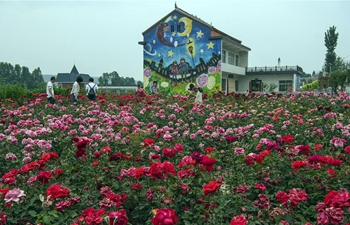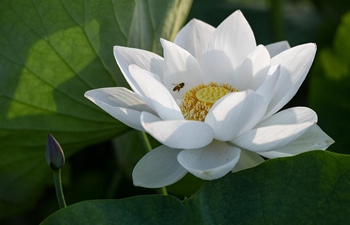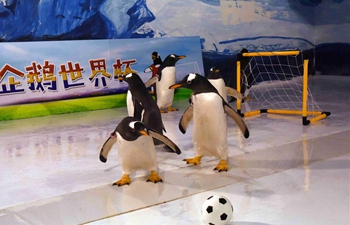XINING, June 17 (Xinhua) -- Traveling through the wilderness of the Qinghai-Tibet Plateau, Guo Zenghong always tells his driver to drive slowly and carefully to avoid hurting young Caragana seedlings on the route.
"It is extremely difficult for seeds and saplings to survive in the desert at a high elevation," said Guo.
"But they are the last hope in turning the desert into an oasis. I hope that no one will damage them," he added.
Working as an engineer in the Gonghe County forestry department in northwest China's Qinghai Province, the 54-year-old has been battling desertification on the Qinghai-Tibet plateau, with an average elevation exceeding 4,500 meters, for nearly 20 years.
Guo was excited after finding that seedlings he planted three years ago in a desert area not only survived but grew even taller than him.
"Thanks to staff from the forestry department and local herders, these cold- and drought-resistant plants have finally taken root in the desert," he said.
The fight against desertification at high altitudes is much harder than other places, as severe weather in different seasons makes the situation worse.
"We have to stabilize the sand dunes first and use straw checkerboard barriers to prevent wind and stop the dunes from moving or expanding," he said.
Qinghai Province has spent more than 300 million yuan (47 million U.S. dollars) on desertification control and prevention projects, with more than 133,000 hectares of land under control last year, according to the provincial forestry department.
In neighboring Gansu Province, scientists are also exploring ways to control desertification in tourist areas.
Yueya Spring, a crescent-shaped lake surrounded by desert in the city of Dunhuang, has attracted millions of tourists from home and abroad.
The site was once under threat because human activities disrupted the ecological balance and changed the flow of wind and sand. Sand dunes were approaching the spring.
Scientists from Northwest Institute of Eco-Environment and Resource under the Chinese Academy of Sciences used technology such as aerial photography and GPS surveys to discover the causes.
"We found that the shrinkage of the spring were mainly because winds from the northeast were blocked or weakened," said Qu Jianjun, researcher and leader of the desertification team at the institute.
"Only with those findings could we take targeted actions to stop the movement of sand dunes toward the spring," Qu said.
So far, the local government has taken a series of actions, such as demolishing buildings and planting bushes instead of tall trees to allow winds to flow and restore the ecological balance of the area. The shrinkage of the spring has been stopped.
"The awareness of targeted desertification policies has been raised among science workers. China has made great progress in desertification control," according to Wang Tao, director of the institute.
China aims to bring 10 million hectares of desertified land under control during the 13th Five-Year Plan (2016-2020) period.

















